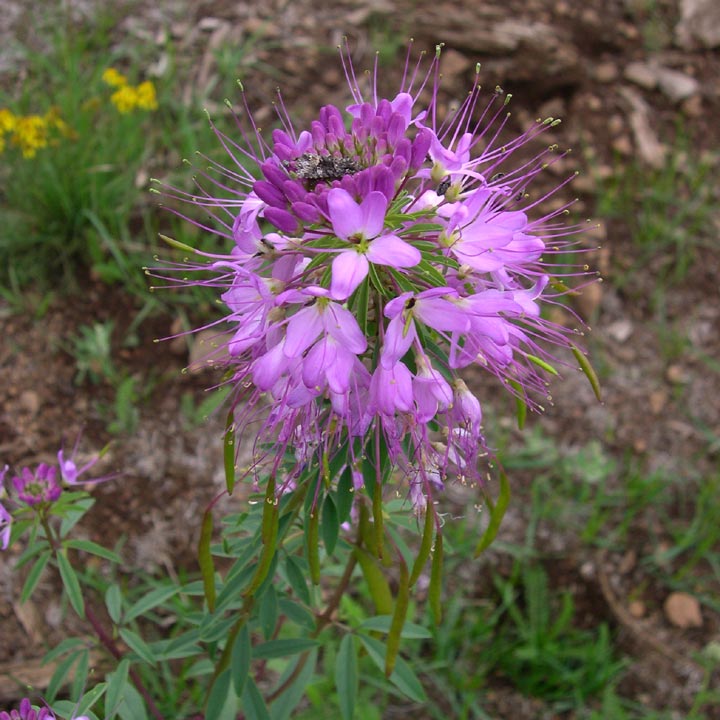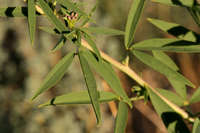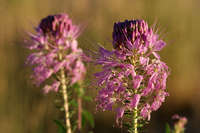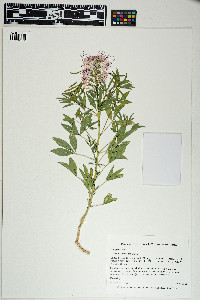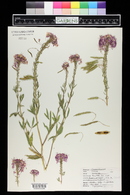|
Family: Cleomaceae
Rocky Mountain beeplant
[ Cleome serrulata Pursh, moreCleome serrulata var. angusta (M.E. Jones) Tidestr., Peritoma serrulata (Pursh) DC.] |
Annual herb 0.5 - 0.8 m tall Stem: branching near top, sometimes having few fine hairs when young, becoming hairless. Leaves: compound with three leaflets (trifoliate), 3 - 6 cm long, narrow lance-shaped, abruptly pointed, non-toothed, often slightly hairy when young. Flowers: borne in a terminal inflorescence (raceme), pink (rarely white), with four sepals and six stamens. The four petals reach 1 cm long with the base narrowing to a short claw. Fruit: an elongated two-valved capsule, long-stalked, 3 - 5 cm long, cylindrical and abruptly contracted at intervals between seeds (torulose), hairless, with interconnecting veins, opening from base to tip, releasing kidney-shaped seeds. Similar species: Cleome hassleriana is easily distinguished from Cleome serrulata because it has leaves with five to seven leaflets and a stem covered in sticky hairs. Polanisia species are distinguished by having more than six stamens, petals with a notched tip, and more or less stalkless fruit. Flowering: July to September Habitat and ecology: Introduced from farther west, this species is occasionally found in disturbed soil. Occurence in the Chicago region: non-native Etymology: Cleome is the ancient name for a mustard-like plant. Serrulata means "with small teeth." Author: The Morton Arboretum Stems 5-8 dm, branched above, pale, glabrous or nearly so; petioles not spiny; lfls 3, narrowly lanceolate, 3-6 cm, sharply acuminate or cuspidate, entire, glabrous at maturity, sometimes finely and sparsely villosulous when young; bracts crowded, lanceolate, short-petioled; pet subequally disposed, pink (white), oblong, 1 cm, the blade narrowed to the base and much exceeding the claw; fr torulose, 3-5 cm, glabrous, the stipe 1.5-2 cm, about equaling the pedicel; 2n reputedly =32, 34, 60. Prairies; Ind. to Mo. and Minn., w. to Sask., Wash., Calif., and Tex. July, Aug.
Gleason, Henry A. & Cronquist, Arthur J. 1991. Manual of vascular plants of northeastern United States and adjacent Canada. lxxv + 910 pp.
©The New York Botanical Garden. All rights reserved. Used by permission. General: Annual, 30-150 cm tall; stems erect, simple or branched above; herbage mostly glabrous, glaucous; taprooted. Leaves: Mostly cauline, alternate, trifoliate, the leaflets lanceolate, oblanceolate, or elliptic, 2-8 cm long, 5-17 mm wide, glabrous, glaucous, margins mostly entire, or sometimes minutely serrate; petioles 0.5-4.5 cm long, the upper blades sessile or nearly so. Flowers: Inflorescence a raceme, densely flowered, elongating in fruit; flowers subtended by simple leaf-like bracts, abruptly smaller than the leaves; pedicels ascending to spreading, 3-10 mm long; sepals 2-3 mm long, united at the base; petals 4-7 mm long, bright to pale yellow; flowers May-August. Fruits: Capsule, more-or-less loosely pendulous, 2-6 cm long, arising on stipes about equal in length to the pedicel; seeds ovoid, 3-4 mm long, brownish black or mottled with gray. Ecology: Open fields, roadsides, disturbed habitats; 1200-2700 m (4500-9000 ft); Apache, Cochise, Coconino, Gila, Graham, Greenlee, Mohave, Navajo, and Yavapai counties; widespread throughout western North America. Notes: Cleome serrulata is a host plant for the cabbage white butterfly. The Navajo use a steeped seed tea as a blood purifier, to improve one-s voice, and to treat colds. Leaves are also used as a natural deodorant. Leaves, flowers, and seed are eaten by the Hopi, Navajo, and Apache, and the Navajo make a yellow-green wool dye from the fermented plant. Editor: Springer et al. 2008 |

